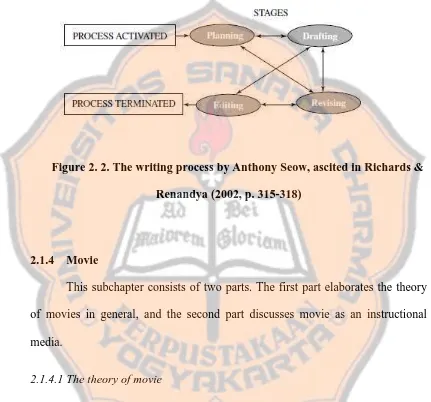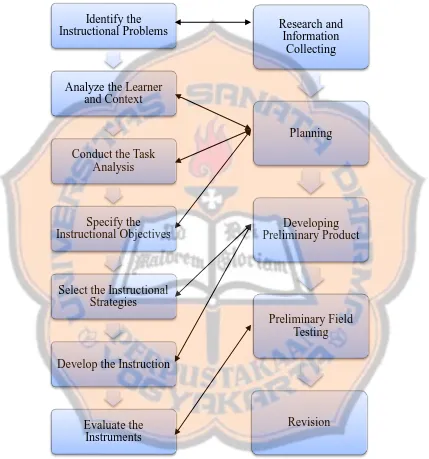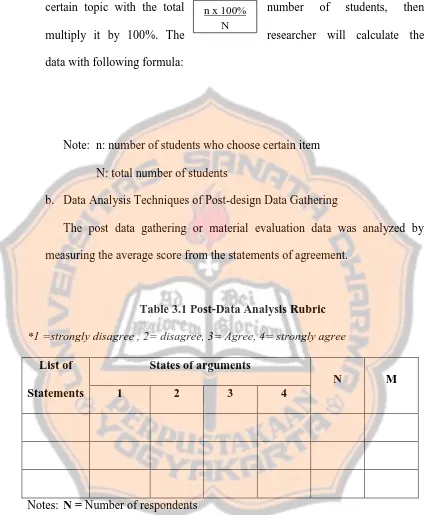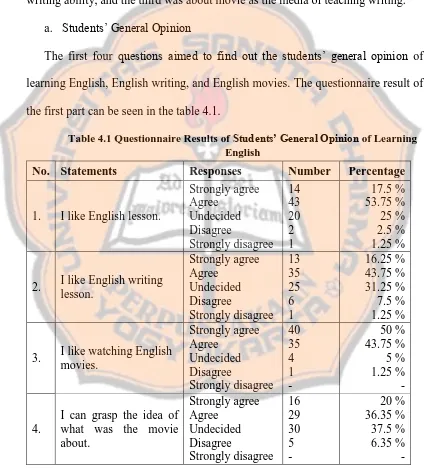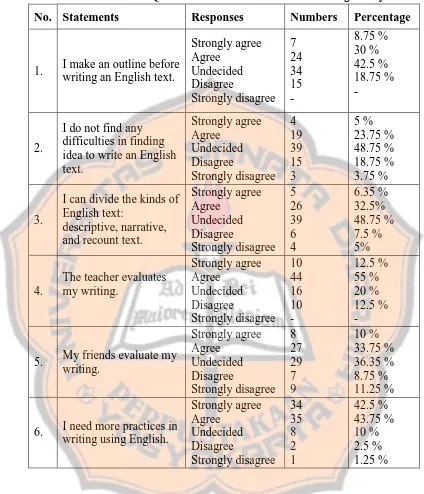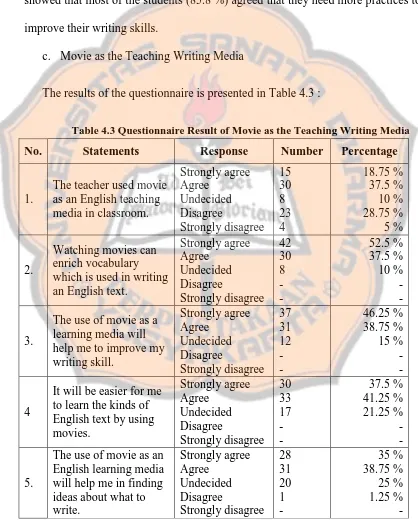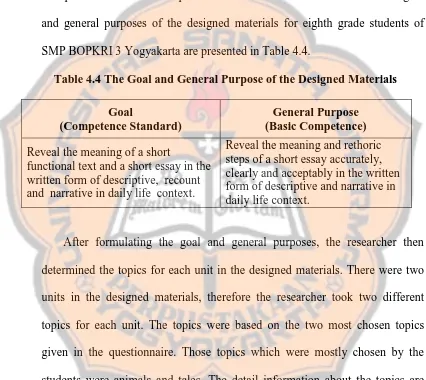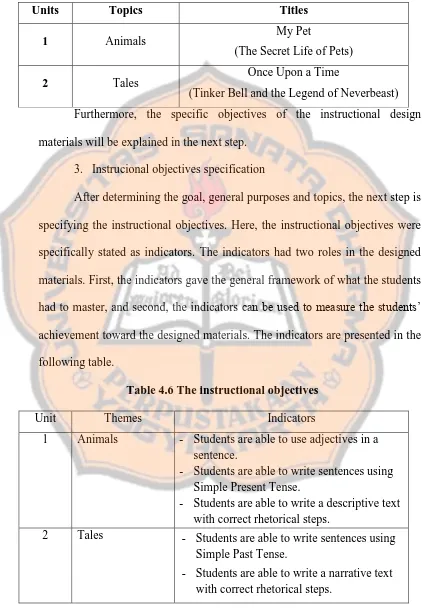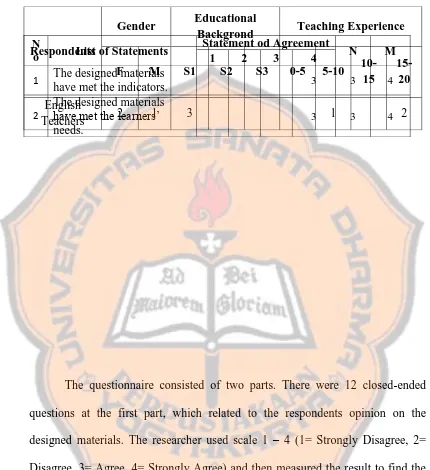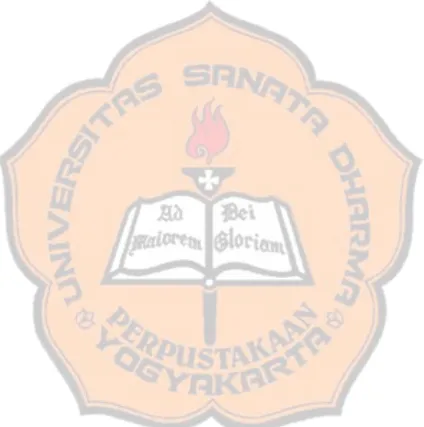vii ABSTRACT
Here, Jervince Inarci Rihi. 2016. Designing Instructional Writing Materials Using Movies for Eighth Grade Students of SMP BOPKRI 3 Yogyakarta. Yogyakarta: Sanata Dharma University.
This study was conducted to design instructional writing materials using movies for eight grade students of SMP BOPKRI 3 Yogyakarta. The idea of conducting this research came from the researcher’s experience when doing teaching practice (Program Pengalaman Lapangan/PPL) in SMP BOPKRI 3 Yogyakarta. The researcher found that most of the students were not motivated in learning English, especially writing. Monotonous activities, uninteresting learning media and also difficult tasks became the students’ problems. Thus, the students needed learning materials which suit their needs and interests.
There were two problems formulated in this research. They were: (1) How are instructional writing materials using movies for eighth grade students of SMP BOPKRI 3 Yogyakarta designed?, and (2) What do instructional writing materials using movies for eighth grade students of SMP BOPKRI 3 Yogyakarta look like?
In conducting this research, the researcher used 5 steps from R&D cycle by Borg and Gall namely information and data collection, planning, preliminary product development, preliminary field testing, instument evaluation, and revision. Moreover, in order to answer the first research problem, the researcher conducted seven steps which were adapted from Morrisson, et al Instructional Design model. Those steps were instructional problems identification, learner and context analysis, task analysis, instructional objectives specification, instructional strategies, instructional development, instrument evaluation, and revision. Then, to answer the second question, the researcher presented the final version of the designed materials. There were two units in the designed materials, namely: My Pet and Once Upon a Time. Each unit is devided into three main parts adopted from the framework of task-based learning. Those parts were Let’s Get Started!, Do Your Task!, and Language Focus.
Furthermore, the designed materials were designed to provide English materials that suit the characteristics of the eighth grade students of SMP BOPKRI 3 Yogyakarta. It consisted of various activities that were intended to increase students’ motivation to learn English, especially writing through movies.
viii ABSTRAK
Here, Jervince Inarci Rihi. 2016. Designing Instructional Writing Materials Using Movies for Eighth Grade Students of SMP BOPKRI 3 Yogyakarta. Yogyakarta: Sanata Dharma University.
Penelitian ini dilakukan untuk merancang seperangkat materi pembelajaran menulis Bahasa Inggris menggunakan film untuk siswa kelas VIII SMP BOPKRI 3 Yogyakarta. Ide melakukan penelitian ini berasal dari pengalaman peneliti ketika melakukan praktek mengajar (Program Pengalaman Lapangan/ PPL) di SMP BOPKRI 3 Yogyakarta. Peneliti menemukan bahwa sebagian besar siswa tidak termotivasi dalam belajar bahasa Inggris, khususnya menulis. Kegiatan belajar mengajar yang monoton, media pembelajaran yang kurang menarik dan tugas yang sulit juga menjadi masalah besar para siswa. Oleh karena itu, para siswa membutuhkan seperangkat materi pembelajaran untuk memenuhi kebutuhan para siswa.
Ada dua rumsan masalah dalam penelitian ini. yaitu: (1) Bagaimana seperangkat materi pembelajaran menulis Bahasa Inggris menggunakan film untuk siswa kelas VIII SMP BOPKRI 3 Yogyakarta dirancang?, dan (2) Bagaimana bentuk seperangkat materi pembelajaran menulis Bahasa Inggris menggunakan film untuk siswa kelas VIII SMP BOPKRI 3 Yogyakarta tersebut?
Dalam melaksanakan penelitian ini, peneliti menggunakan 5 langkah metode Penelitian dan Pengembangan oleh Borg dan Gall yaitu pengumpulan data dan informasi, perencanaan, pengembangan produk, evaluasi perangkat, dan revisi. Lebih dari itu, untuk menjawab rumusan masalah pertama, peneliti mengadaptasi tujuh langkah yang diadaptasi dari model perancangan pembelajaran dari Morrisson, et al. Langkah-langkah tersebut yaitu identifikasi masalah pembelajaran, analisis karakter siswa dan konteks, analisis bahan ajar, merumuskan tujuan pembelajaran, menyeleksi strategi pembelajaran, pengembangan materi pembelajaran, dan evaluasi instrument. Selanjutnya, untuk menjawab pertanyaan kedua, peneliti mempresentasikan versi akhir dari materi pembelajaran yang dirancang. Rancangan pembelajaran ini terdiri dari dua unit, yaitu: My Pet dan Once Upon a Time. Masing-masing unit terbagi menjadi tiga bgaian yang diadaptasi dari task-based learning cycle, yaitu: Let’s Get Started!, Do Your Task!, and Language Focus.
Selain itu, pembelajaran ini dirancang untuk menyediakan materi Bahasa Inggris yang sesuai dengan karakteristik siswa kelas VIII SMP BOPKRI 3 Yogyakarta. Ini terdiri dari berbagai tugas yang ditujukan untuk meningkatkan motivasi siswa dalam belajar Bahasa Inggris, khususnya menulis melalui film.
YOGYAKARTA
A SARJANA PENDIDIKAN THESIS
Presented as Partial Fulfillment of the requirements to Obtain the Sarjana Pendidikan Degree
in English Language Education
By
Jervince Inarci Rihi Here Student Number: 101214017
ENGLISH LANGUAGE EDUCATION STUDY PROGRAM DEPARTEMENT OF LANGUAGE AND ARTS EDUCATION
FACULTY OF TEACHERS TRAINING AND EDUCATION SANATA DHARMA UNIVERSITY
i
DESIGNING INSTRUCTIONAL WRITING MATERIALS
USING MOVIES FOR EIGHTH GRADE STUDENTS OF SMP
BOPKRI 3 YOGYAKARTA
A SARJANA PENDIDIKAN THESIS
Presented as Partial Fulfillment of the requirements to Obtain the Sarjana Pendidikan Degree
in English Language Education
By
Jervince Inarci Rihi Here Student Number: 101214017
ENGLISH LANGUAGE EDUCATION STUDY PROGRAM DEPARTEMENT OF LANGUAGE AND ARTS EDUCATION
FACULTY OF TEACHERS TRAINING AND EDUCATION SANATA DHARMA UNIVERSITY
iv
DEDICATION PAGE
“
He has made everything beautiful in its time: also He has put
eternity in men’s hearts, so that no man can find out the work that
God does from the beginning to the end.”
Ecclesiastes 3 : 11
v
STATEMENT OF WORK’S ORIGINALITY
I honestly declare that this thesis, which I have written, does not contain the work or parts of the work of the other people, except those cited in the quotation and the references, as a scientific paper should.
Yogyakarta, 13 December 2016 The writer
vi
LEMBAR PERNYATAAN PERSETUJUAN
PUBLIKASI KARYA ILMIAH UNTUK KEPENTINGAN AKADEMIS
Yang bertanda tangan di bawah ini, saya mahasiswi Universitas Sanata Dharma:
Nama : Jervince Inarci Rihi Here Nomor Mahasiswa : 101214017
Demi pengembangan ilmu pengetahuan, saya memberikan kepada Perpustakaan Universitas Sanata Dharma karya ilmiah saya yang berjudul:
DESIGNING INSTRUCTIONAL WRITING MATERIALS USING MOVIES FOR EIGHTH GRADE STUDENTS OF SMP BOPKRI 3
YOGYAKARTA
beserta perangkat yang diperlukan (bila ada). Dengan demikian, saya memberikan kepada Perpustakaan Universitas Sanata Dharma hak untuk menyimpan, mengalihkan dalam bentuk lain, mengelolanya dalam bentuk pangkalan data, mendistribusikannya di internet atau media lain untuk kepentingan akademis tanpa perlu meminta ijin maupun royalti kepada saya selama tetap mencantumkan nama saya sebagai penulis.
Demikian pernyataan ini saya buat dengan sebenarnya. Dibuat di Yogyakarta
Pada tanggal: 8 February 2017 Yang menyatakan,
vii ABSTRACT
Here, Jervince Inarci Rihi. 2016. Designing Instructional Writing Materials Using Movies for Eighth Grade Students of SMP BOPKRI 3 Yogyakarta. Yogyakarta: Sanata Dharma University.
This study was conducted to design instructional writing materials using movies for eight grade students of SMP BOPKRI 3 Yogyakarta. The idea of conducting this research came from the researcher’s experience when doing teaching practice (Program Pengalaman Lapangan/PPL) in SMP BOPKRI 3 Yogyakarta. The researcher found that most of the students were not motivated in learning English, especially writing. Monotonous activities, uninteresting learning media and also difficult tasks became the students’ problems. Thus, the students needed learning materials which suit their needs and interests.
There were two problems formulated in this research. They were: (1) How are instructional writing materials using movies for eighth grade students of SMP BOPKRI 3 Yogyakarta designed?, and (2) What do instructional writing materials using movies for eighth grade students of SMP BOPKRI 3 Yogyakarta look like?
In conducting this research, the researcher used 5 steps from R&D cycle by Borg and Gall namely information and data collection, planning, preliminary product development, preliminary field testing, instument evaluation, and revision. Moreover, in order to answer the first research problem, the researcher conducted seven steps which were adapted from Morrisson, et al Instructional Design model. Those steps were instructional problems identification, learner and context analysis, task analysis, instructional objectives specification, instructional strategies, instructional development, instrument evaluation, and revision. Then, to answer the second question, the researcher presented the final version of the designed materials. There were two units in the designed materials, namely: My Pet and Once Upon a Time. Each unit is devided into three main parts adopted from the framework of task-based learning. Those parts were Let’s Get Started!, Do Your Task!, and Language Focus.
Furthermore, the designed materials were designed to provide English materials that suit the characteristics of the eighth grade students of SMP BOPKRI 3 Yogyakarta. It consisted of various activities that were intended to increase
students’ motivation to learn English, especially writing through movies.
viii ABSTRAK
Here, Jervince Inarci Rihi. 2016. Designing Instructional Writing Materials Using Movies for Eighth Grade Students of SMP BOPKRI 3 Yogyakarta. Yogyakarta: Sanata Dharma University.
Penelitian ini dilakukan untuk merancang seperangkat materi pembelajaran menulis Bahasa Inggris menggunakan film untuk siswa kelas VIII SMP BOPKRI 3 Yogyakarta. Ide melakukan penelitian ini berasal dari pengalaman peneliti ketika melakukan praktek mengajar (Program Pengalaman Lapangan/ PPL) di SMP BOPKRI 3 Yogyakarta. Peneliti menemukan bahwa sebagian besar siswa tidak termotivasi dalam belajar bahasa Inggris, khususnya menulis. Kegiatan belajar mengajar yang monoton, media pembelajaran yang kurang menarik dan tugas yang sulit juga menjadi masalah besar para siswa. Oleh karena itu, para siswa membutuhkan seperangkat materi pembelajaran untuk memenuhi kebutuhan para siswa.
Ada dua rumsan masalah dalam penelitian ini. yaitu: (1) Bagaimana seperangkat materi pembelajaran menulis Bahasa Inggris menggunakan film untuk siswa kelas VIII SMP BOPKRI 3 Yogyakarta dirancang?, dan (2) Bagaimana bentuk seperangkat materi pembelajaran menulis Bahasa Inggris menggunakan film untuk siswa kelas VIII SMP BOPKRI 3 Yogyakarta tersebut?
Dalam melaksanakan penelitian ini, peneliti menggunakan 5 langkah metode Penelitian dan Pengembangan oleh Borg dan Gall yaitu pengumpulan data dan informasi, perencanaan, pengembangan produk, evaluasi perangkat, dan revisi. Lebih dari itu, untuk menjawab rumusan masalah pertama, peneliti mengadaptasi tujuh langkah yang diadaptasi dari model perancangan pembelajaran dari Morrisson, et al. Langkah-langkah tersebut yaitu identifikasi masalah pembelajaran, analisis karakter siswa dan konteks, analisis bahan ajar, merumuskan tujuan pembelajaran, menyeleksi strategi pembelajaran, pengembangan materi pembelajaran, dan evaluasi instrument. Selanjutnya, untuk menjawab pertanyaan kedua, peneliti mempresentasikan versi akhir dari materi pembelajaran yang dirancang. Rancangan pembelajaran ini terdiri dari dua unit, yaitu: My Pet dan Once Upon a Time. Masing-masing unit terbagi menjadi tiga bgaian yang diadaptasi dari task-based learning cycle, yaitu: Let’s Get Started!, Do Your Task!, and Language Focus.
Selain itu, pembelajaran ini dirancang untuk menyediakan materi Bahasa Inggris yang sesuai dengan karakteristik siswa kelas VIII SMP BOPKRI 3 Yogyakarta. Ini terdiri dari berbagai tugas yang ditujukan untuk meningkatkan motivasi siswa dalam belajar Bahasa Inggris, khususnya menulis melalui film.
ix
ACKNOWLEDGEMENTS
First of all, I would like to address my greatest gratitude to My Lord Jesus Christ, for His love, grace and blessings during my whole life. He gives me strength to finally finish this thesis.
My deepest gratitude goes to my advisor, Concilianus L. Mbato, M.A., Ed.D., for his patience, guidance and motivation during the process of writing this thesis. I also greatly thank all PBI Sanata Dharma lecturers who had patiently taught and given me knowledge to prepare me to become a good teacher.
I also would like to thank the eighth grade students of SMP BOPKRI 3 Yogyakarta and also Renung Bakirna, S. Pd., as the English teacher for helping me in conducting this research. My sincerest gratitude goes to Atun Pratiwi, M. Pdk., as the principal of SMP BOPKRI 3 Yogyakarta and all the teachers and students who supported me during my research in school and accepted me as a family.
x
Last but not least, I would like to thank every single person who has come to my life and let me learn many things from your presence. May The Good Lord bless you all.
xi
TABLE OF CONTENTS
Page
TITLE PAGE ... i
APPROVAL PAGES ... ii
DEDICATION PAGE ... iv
STATEMENT OF WORK’S ORIGINALITY ... v
PERNYATAAN PERSETUJUAN PUBLIKASI ... vi
ABSTRACT ... vii
ABSTRAK ... viii
ACKNOWLEDGEMENTS ... ix
TABLE OF CONTENTS ... xi
LIST OF TABLES ... xiv
LIST OF FIGURES ... xv
LIST OF APPENDICES ... xvi
CHAPTER I: INTRODUCTION A. Research Background ... 1
B. Research Problems ... 5
C. Problem Limitation ... 5
D. Research Objectives ... 5
E. Research Benefits ... 6
xii
CHAPTER II: REVIEW OF RELATED LITERATURE
2.1 Theoretical Description ... 9
2.1.1 Instructional Design ... 9
2.1.2. Task-based Learning ... 14
2.1.2.1 Definition of TBL ... 14
2.1.2.2 The Framework of TBL ... 16
2.1.3 Writing ... 17
2.1.4 Movie ... 21
2.1.4.1 The Theory of Movie ... 21
2.1.4.2 Movie as the Instructional Media ... 24
2.2 Theoretical Framework ... 28
CHAPTER III: RESEARCH METHODOLOGY 3.1 Research Method ... 30
3.2 Research Setting ... 34
3.3 Research Participants ... 34
3.4. Research Instrument and Data Gathering Technique ... 34
3.5 Data Analysis Technique ... 36
3.6 Research Procedure ... 38
xiii
4.1.1 Questionnaire Results... 40
4.1.2 Interview Results ... 47
4.2 Discussion ... 49
4.2.1 The Process of Material Design ... 50
a. Data Collecting ... 50
b. Planning ... 51
c. Developing preliminary product ... 54
d. Evaluating instrument ... 55
e. Revision ... 58
4.2.2 The General Description of the Design Materials ... 59
CHAPTER V: CONCLUSIONS AND SUGGESTIONS 5.1. Conclusions ... 61
5.2 Recommendations ... 63
1. For English Teacher ... 63
2. Future Researchers ... 63
REFERENCES ... 64
xiv
LIST OF TABLES
Table Page
3.1 Post-Data Analysis Rubric ... 37
4.1 Questionnaire Result of Students’ General Opinion of Learning English 41
4.2 Questionnaire Result of Students’ Writing Ability ... 43
4.3 Questionnaire Result of Movie as the Teaching Writing Media ... 45
4.4 The Goal and General Purpose of the Design Materials ... 52
4.5 The Topics of the Instructional Materials ... 53
4.6 The Instructional Objectives ... 53
4.7 Personal Information of the Respondents ... 56
xv
LIST OF FIGURE
Figure Page
xvi
LIST OF APPENDICES
Appendices Page
Appendix A Letter of Permission ... 70
Appendix B Pre-design Questionnaire ... 72
Appendix C Lesson Plan ... 77
Appendix D Post Design Questionnaire ... 84
Appendix E The Final Version of The Designed Materials ... 86
1 CHAPTER I
INTRODUCTION
This first chapter will discuss the background of the study. There will be six parts in this chapter, which are research background, research problems, problem limitation, research objectives, research benefits, and definition of terms.
1.1 Research Background
English has become lingua franca for people worldwide. It is used globally as „a contact language between persons who share neither a common native tongue
nor a common (national) culture, and for whom English is the chosen foreign language of communication‟ (Firth, as cited in Seidlhofer, 2005). As a
communication tool, English helps people worldwide connected in many aspects, such as technology, entertainment, health, education, and also economy. Therefore, it is important to learn English especially in this globalization era, where those aspects develop rapidly.
the English words are pronounced differently from the written forms, unlike Bahasa (native language of Indonesia). Moreover, 87.2% of the students said that they have poor basic knowledge about English, including grammar and vocabulary (Nurkamto, 2002). That was quite contrast since in Indonesia, English is taught from elementary school until senior high school and also becomes one of the require subjects to pass the national examination. Furthermore, according to Mbato (2013), there are some reasons why learning English for many students is difficult. First, learning English mostly takes place in classroom contexts. Students only have a little experience to practice English in real communication context. The learning depends on the teacher and materials that the teacher gives in the classroom. Nevertheless, students have low motivation to learn more from other sources. Although internet has provided accessible English language learning resources, not many students have initiative or skill to use it, but for those who do, “they tend to do so in an instrumental way, merely to accomplish
classroom assignments”. The other reason is that most of the students learn
English merely because it is a compulsory (p. 2).
are used to support teaching and learning process. Those include textbooks, video and audio tapes, computer software, and visual aids. However, in order to apply the materials effectively, the teacher should consider to use the appropriate materials in the classroom. According to Kitao (1997), appropriate materials need to have “an underlying instructional philosophy, approach, method and technique which suit the students and their needs”. Therefore, it is important for teachers to choose and adapt the materials based on their students‟ needs and interests.
The idea of conducting this research came from the researcher‟s experience when doing teaching practice (Program Pengalaman Lapangan/PPL) in SMP BOPKRI 3 Yogyakarta. When doing observations on the eighth grade classes of
SMP BOPKRI 3 Yogyakarta, the researcher found that most of the students were not motivated in learning English, especially writing. Monotonous activities and uninteresting learning media used by the teacher made the students felt bored in following the English class. Some students said that writing tasks given by the teacher were too difficult for the students. That was also because they were lack of vocabulary and grammar mastery yet did not have enough chance to practice on those skills.
entertainment tools for the students rather than learning media. There were no follow up activities related to the lesson learned. That is why the researcher decided to use movie as the learning media for the eighth grade students of SMP BOPKRI 3 Yogyakarta. The researcher expected that the movies not only can increase the students motivation in learning English, but also assist the students in learning English writing.
Task-based learning approach is chosen to be applied in the material design. According to Nunan (2004), the aim of task-based language learning is to “provide opportunities for learners to experiment with and explore both spoken
and written language through learning activities that are designed to engage learners in the authentic, practical and functional use of language for meaningful purposes” (p. 13). This approach also uses student-centered technique which is
suitable to be applied for the eighth grade students of SMP BOPKRI 3 Yogyakarta. Students-centered based technique and various tasks are expected to help the students improving their writing skill.
1.1.1 Research Problems
There are two research problems which are investigated in this research:
1. How are instructional writing materials using movies for eighth grade students of SMP BOPKRI 3 Yogyakarta designed?
2. What do instructional writing materials using movies for eighth grade students of SMP BOPKRI 3 Yogyakarta look like?
1.1.2 Problem Limitation
This research is focused on the process of designing writing materials using movies for the eighth grade students of SMP BOPKRI 3 Yogyakarta. Movies that are used as the learning media are chosen according to the students age and level. Task-based learning approach is applied in the designed material to allow students do more practice on writing skills.
1.1.3 Research Objectives
According to the research problems, this research is conducted in order to:
1. Find out how instructional writing materials using movies for eighth grade students of SMP BOPKRI 3 Yogyakarta are designed.
1.1.4 Research Benefits
This research is expected to give benefits to some sides. They are: 1. Students of SMP BOPKRI 3 Yogyakarta
This research is expected to help eighth grade students of SMP BOPKRI 3 Yogyakarta in learning the English writing skill. Through movies and interesting writing tasks and activities, it is also expected to increase the student‟s motivation to practice English writing more, get better in mastering simple grammar and vocabulary, and also to achieve the indicators of the materials given by the teacher. Moreover, by using movie as the learning media, it will be easier for the students to develop the topics and ideas about what to write.
2. English Teachers of SMP BOPKRI 3 Yogyakarta
This research is also aimed at helping the English teachers of SMP BOPKRI 3 Yogyakarta in providing an interesting and appropriate teaching writing materials to be applied in the classroom. Since the material designed is based on the students‟ needs and interests, it will be easier for the teacher to teach the whole
class. Also, through the varied activities and tasks, hopefully this designed material can be used to create an interesting and fun class athmosphere while teaching English writing.
3. Other Researchers
1.1.5 Definition of Terms
This part aims to define the term used in this study in order to clarify the concept and avoid misinterpretation.
1.1.5.1 Instructional design
According to Dick & Reiser (1989), instructional design is a systematic process for designing, developing, implementing, and evaluating instruction (p. 3). In this research, the instructional design is a process of designing, developing and evaluating instructional writing materials using movie for the eighth grade students of SMP BOPKRI 3 Yogyakarta. However, the material designed will not be implemented in this research.
1.1.5.2 Writing
1.1.5.3 Movie
Movie is close to people‟s daily life. It does not only entertain, but also
can give information and knowledge about cultures, languages, and people worldwide. Oxford Dictionary define movie as “a series of moving pictures recorded with sound that tells a story, shown at the cinema/movie theatre”
(“Movie”).
Movie can also be an effective media in language learning. Ismaili (2013) states that movies give “exposureto “real language” used in authentic settings and in the cultural context which the foreign language is spoken.” In other
CHAPTER II
REVIEW OF LITERATURE
In this chapter, the researcher will discuss related theories that are used in conducting the research. This chapter will be divided into two sub-chapters, which are theoretical description and theoretical framework.
2.1 Theoretical Description
This section provides the related theories used in this research. The theories used are Instructional Design, Task-Based Learning, Writing, and Movie.
2.1.1 Instructional Design
Instructional design is a systematic process for designing, developing, implementing, and evaluating instruction (Dick & Reiser, 1989, p. 3). The instructional design method that is used in this research is Kemp‟s instructional
design model that has been modified by Morrison, Ross, Kalman and Kemp in 2011. According to Morrison, Ross, Kalman, and Kemp (2011) the purpose of instructional design is to make learning more “efficient, effective and less difficult” (p. 2). Therefore, Morrison, et al (2011) maintain the four fundamental
you determine the extent to which learning is achieved? (Evaluation procedures) (p. 14).
Further, those four basic components will be analyzed using nine steps of instructional design planning proposed by Morrisson, et al (2011), which are:
2.1.1.1Identify the Instructional Problems
The first step of instructional design process is identifying the learner needs or problems. This is the initial process which aimed to determine whether instruction should be a part of the solution. If the problems or needs seek an instruction as the solution, then the researcher may continue doing the project. However, if the needs seek a non-instructional solution, then the designer may apply the non-instructional intervention or find the most appropriate solution (Morrison et al 2011, p. 15). In order to identify the instructional problems, there are three different approaches that can be used by the researcher. They are, needs assessment, goal analysis, and performance assessment (2011, p. 31). The researcher has to carefully identify the needs and problems since this research is focused on designing the instructional model.
2.1.1.2Analyze the Learner and Context
ethnicity), specific entry characteristics (prerequisite skills for the instruction), and learning styles (preferred ways of learning). Connected to the learner analysis is contextual analysis, which provides information about environmental factors that will affect the design and deliver the instruction (p. 70).
2.1.1.3Conduct the Task Analysis
After analyzing the learner characteristics and context, the next step is analyzing the task. The process of task analysis is to define the subject content, and analyze task components related to stated goals and purposes. As stated by Morrison, et al (2011), “Task analysis is probably the most critical step in the instructional design process” (p. 78). The appropriate content in the instruction can help the learners to master the objectives. In order to conduct the task analysis the researcher can use three techniques. They are: topic analysis, which describe how to define a cognitive knowledge, procedural analysis that include a series of steps to do the task analysis and critical incident method which is for analyzing interpersonal skill (p. 79).
2.1.1.4 Specify the Instructional Objectives
According to Morrison, et al (2011), “the specification of instructional objectives plays a key role in the procedure for systematically planning instruction” (p. 128). The instructional objective gives a clear guidance for
attitudes defined by the analysis. Further, the objectives are used as the starting point to select the instructional strategies.
2.1.1.5 Manage the Content Sequence
This step focuses on presenting content in the most appropriate sequence related to the objectives. Having an appropriate order of content sequence can help learners grasp the ideas and information in more efficient and effective way (p. 15, 136).
2.1.1.6 Select the Instructional Strategies
The instructional strategy provides the designer to develop the sequence instructional contents that are specified in the previous step. In this step, the designer focuses on how to present each objective in a way that will help learners achieve the objectives.
2.1.1.7 Design the Message
The message in this step refers to the pattern of words and pictures that is used to present the information to the learner. The designer has to pay attention in selecting the appropriate graphics, text, and style in presenting the content since it can enhance the learners‟ understanding of the instruction.
2.1.1.8 Develop the Instruction
process, the researcher should focus on the problem and objectives to ensure the instruction supports the resolution of the problem (p. 234)
2.1.1.9 Evaluate the Instruments
The last step of this instructional model is evaluating the instruments. This is an essential step that should be done by the designer to measure the learners‟
mastery of the objectives. It can be done in some ways, such as, multiple choice, test items, or portfolio collection.
The nine steps of Kemp‟s Instructional Model in Morrison, et.al (2011) are
presented in an oval shape to indicate that there is no rule of sequence or order in applying the steps. The instructional designer can begin and finish the steps from anywhere based on the needs of the user of the instructional materials. The instructional design plan that is proposed by Kemp is drawn as the following figure:
2.1.2 Task-based Learning
There are two things which will be discussed in this theory of task-based learning. They are definition of task-based learning and framework of task-based learning.
2.1.2.1 Definition of Task-based Leaning
According to Nunan (2004), “task-based language learning aims at providing opportunities for learners to experiment with and explore both spoken and written language through learning activities that are designed to engage learners in the authentic, practical and functional use of language for meaningful purposes” (p. 13). In other words, while doing tasks, learners have chance to
interact with other learners by using the target language in classroom.
In teaching-learning process, task-based learning uses the learner-centered principle. Learners are given more opportunities to explore the target language both in spoken and written form in classroom. While learners are the center in the teaching-learning process, on the other hand, the teacher plays role as a „facilitator‟ who is involved in setting the task up and makes sure that the learners
There are seven types of tasks according to Pattinson, as cited in Nunan (2004), which are:
1. Question and Answer
These activities are based on the concept of creating information gap by letting the learners make a personal and secret choice from a list of language items which all fit into a given frame.
2. Dialogue and Role Play
These activities can be wholly scripted and wholly improvised. The wholly improvised can be given if the students have some choices of what to say and if there is a clear objective tobe achieved by what they say in the role play.
3. Matching Activities
In these activities, the students are asked to recognize the matching items or complete pairs or sets.
4. Communication Strategies
5. Pictures and picture series
Many communication activities can be stimulated through the use of pictures and picture stories. The activity can be such as memory test, spot the difference, and sequencing pictures to tell a story.
6. Puzzle and problems
These activities require the learners to make guesses, draw on their general pknowledge and personal experience, use their imagination, and test their power of logical reasoning.
7. Discussions and decisions
In this activity, the learners collect and share the information in order to reach a decision.
Those types of task can be used by the teacher to deliver the lessons and also to help students achieve the learning objectives well.
2.1.2.2 The Framework of Task-based Learning
Moreover, to help teacher arrange the tasks in teaching learning proccess, Willis (1996) forms the framework of task-based learning which is consisted of three phases. They are pre-task, task cycle, and language focus/post task.
a. Pre-task
learners understand the task instructions, and prepare (Willis, 1996, p. 38). In this phase, the students are also motivated by some brainstorming tasks in order to make the students interested to learn more about the topic which is discussed.
b. Task cycle
The task cycle consists of three parts, which are task, planning, and report. The task stage provide learners opportunity to use the target language in whatever form they can. Pairs works or small group tasks are involved in this stage. After doing the tasks, the learning process moves to the planning stage. In this stage, the learners do the preparation to report the result of their work to the whole class (orally or writing). Lastly, the students report their results to the whole class. The teacher may give brief feedback and positive note to what the learners have done in order to increase the learners‟ motivation to learn more (Willis 1996, p. 52-61).
c. Language focus/ Post-task
The last phase in task-based learning framework is the language focus/post-task. In this phase the learners analyze the texts, transcripts and sets of examples taken from the tasks they have done in previous phase. After that, the learners do practice of words, phrases, pattern and sentences from the analysis activities (Willis 1996, p. 38, 100).
2.1.3 Writing
and paragraphs that will be clear to the reader (p. 88). In other words, writing is the process of expressing ideas in written form.
2.1.3.1 Writing process
According to Cohen (1990), writing is a process when the final product comes after a series of stages. The writing process is also defined as an activity comprising four main stages, which are planning, drafting, revising and editing. However, those stages are “neither sequential nor orderly” (Seow, as cited in Richards & Renandya, 2002). Here, the students can explore new ideas, words, and sentences that they plan, write the drafts, revise and edit their writing. Furthermore, Seow, as cited in Richards & Renandya (2002) elaborates the stages of writing process as follows:
a. Planning (pre-writing)
Planning or pre-writing is any activity in the classroom that encourages students to write. This stage aims to stimulate students to start writing by generating tentative ideas and gathering information about what to write. Some activities that can be applied in this stage are:
- Group brainstorming
The group members spontaneously talk about anything related to the topic. Here, there are no right or wrong answers. The students are given chance to widely express their ideas related to a topic given.
- Clustering
activity helps students to draw a visual connection of ideas that they cannot explain in words or sentences.
- Rapid free writing
Students individualy write down single words and phrases about a topic freely and quickly within a limited time of 1 or 2 minutes. The time limit keeps the writers‟ minds ticking and thinking fast. Rapid free writing is done
when group brainstorming is not possible or because the personal nature of a certain topic requires a different strategy.
- WH-questions
Students form WH-questions (who, why, what, where, when and how) about a topic. The ideas for writing can be obtained from multimedia sources (e.g., printed material, videos, films), as well as from direct interviews, talks, surveys, and questionnaires.
During this pre-writing stage, students will be more motivated to write when they are given variety of materials for gathering information (Seow, as cited in Richards & Renandya, 2002).
b. Drafting
always for the teacher, the students may also be encouraged to write for different audiences, among whom are peers, other classmates, pen-friends and family members. Once the students know their audience, they can be directed to a certain style in their writing as well as to communicate with their audience.
c. Responding
This stage of writing is done between drafting and revising stage. Responding which is done by teacher (of by peers) plays central role in the successful implementation of process writing. The response can be oral or written comments, suggestions, or corrections, and given after the students have produced the first draft and just before they proceed to revise.
d. Revising
The students revise their writing based of the feedback given in the responding stage. They reexamine what was written to see how effectively they have communicated their meanings to the reader. Revising is not merely checking for language errors (i.e., editing). It is done to improve global content and the organisation of ideas so that the writer‟s intent is made clearer to the reader.
e. Editing
As have been said before, those stages in the proces of writing are not sequential. Students can repeat the stages to practice and improve their writing. The writing stages are described in the following figure.
Figure 2. 2. The writing process by Anthony Seow, ascited in Richards & Renandya (2002, p. 315-318)
2.1.4 Movie
This subchapter consists of two parts. The first part elaborates the theory of movies in general, and the second part discusses movie as an instructional media.
2.1.4.1The theory of movie
Movie is close to people‟s daily life. It is not only entertain, but also can
and attention of the audience (p. 37). Thus, movies widely become entertainment tools for most people worldwide.
Movie has various genres. John M. Grace (2008) classifies the primary genres of movie as follows:
a. Action
Action movies usually include high energy, big-budget physical stunts and chases, possibly with rescues, battles, fights, escapes, races against time and crises featuring non-stop motion, break-neck rhythm and pacing.
b. Adventure
Adventure movies are exciting stories, with new experiences or exotic locales. This genre is quite similar to or often paired with the action genre. The difference between the two genres is adventure movies show more the struggles, explorations, and situations that the character goes through, while action focuses more on the violence (Tim Dirks, n.d).
c. Comedy
Comedies are light-hearted plots deliberately designed to amuse and provoke laughter by exaggerating the situation, language, action, relationships and characters.
d. Crime
e. Drama
Dramas are serious, portraying realistic characters in conflict with themselves, others and nature; settings, life situations, and stories involving intense character development and interaction.
f. Epic
The epic movies take an historical or imagined event, mythic, legendary, or heroic figure, and add an extravagant setting and lavish costumes, accompanied by magnificence and spectacle, dramatic scope, and high production values.
g. Horror
Horror movies are designed to frighten and to invoke fears. That often in a terrifying, shocking finale, while captivating and entertaining the audience at the same time in a cathartic experience.
h. Musical/dance
This genre of movie is cinematic forms that emphasize song and dance routines in a significant way. In other words, musicals/dances are movies that are centered on combinations of music, dance, song or choreography.
i. Science Fiction (Sci-fi)
Sci-fi movies are often quasi-scientific, visionary and imaginative - complete with heroes, aliens, distant planets, quests, fantastic places, new technology, and extraordinary monsters. Sci-fi films often feature multiple genres.
k. Westerns
Western are the major defining genre of the American movie industry. The movies are one of the oldest, most enduring genres with very recognizable plots, elements, and characters (six-guns, horses, dusty towns and trails, cowboys, Indians, etc.).
2.1.4.2Movie as the instructional media
Besides being an entertainment tools, movie can also be an effective media in language learning. Kusumarasdyati and Luo find that movies can grab the learners‟ interest and it can positively affect their motivation to learn (as cited in
Ismaili, 2013). Moreover, Chan and Herrero (2010) add:
learning languages through film can increase language learners‟ intercultural understanding, as well as helping them to become aware of the similarities and differences between cultures, such as everyday life, education, traditions, social customs, religious beliefs, and events of national importance.
Moreover, Donaghi (2014) pointed out the benefits of movie as learning media as follows:
- Learning from movies is motivating and enjoyable
Motivation is an important thing in learning language. Movie has become a part of students‟ live so it can be effective to bring it into the classroom. Movie, as
- Movie provides authentic and varied language
Movie provides students with examples of English used in „real‟ situations
outside the classroom, particularly interactive language – the language of real-life conversation. Movie or film exposes students to natural expressions and the natural flow of speech. For the students who are not living in an English-speaking environment, perhaps movie and television can provide learners with this real-life language input.
- Movie gives a visual context
Movie can be an invaluable teaching tool becase it provides a visual context which enable students to learn and understand more by interpreting the language in a full visual context. Movie also assists the students‟ comprehension through listening to the language exchanges and see such visual supports as facial expressions and gestures simultaneously. These visual clues support the verbal message and provide a focus of attention.
- Movie brings variety and flexibility
such as discussions, debates on social issues, role plays, reconstructing a dialogue or summarising.
Moreover, in order to use movies in a language classroom, there are some techniques that can be used. In this research, the researcher combines techniques provide by Berk (2009) and Barile (2014). Those are:
a. Provide content and information
In this technique, teacher select an appropriate movie to be applied in classroom. Those cover the genre of movie, content appropriateness with learners‟ age, and duration. In order to find out the content appropriate However, in applying the movie in classroom, it is not necessary to watch the entire movie. The teacher can pick the movie parts which are suitable with the materials. If teacher wants students to watch the entire movie, assign that viewing outside the class. In addition, Barile (2014) argue that teacher should choose films that students probably have not seen before, or the movie may be the teacher‟s personal favorites. According to Barile, “a teacher's enthusiasm can be contagious.”
b. Apply content to real-world applications
Students need real-world applications to see the relevance of what they are learning. In this case, Movies can provide very graphic, explicit examples of a wide range of content (Berk, 2009). Students can also easily understand the lesson learned beacause the students can experience it in real life.
The creativity of teacher is needed in this technique. This technique is mainly to grab students‟ attention and interest in following the class. Berk (2009) also provides several options: (a) ask students for their immediate reactions in an open discussion, (b) direct a small group collaborative learning activity with specific questions to answer, (c) ask pivotal questions about the clip to introduce the topic, (d) request students to write a minute paper response, or (e) engage students in a think-pair-share with or without a leading question. Those options can stimulate learners to follow the lesson well.
d. Consider the pedagogical approaches and technology that can be used. Teacher can use different approaches and technology according to the learners‟ need. For example, Barile (2014) uses "flipped" learning to facilitate learning through discovery. Barile also creates instructional and background videos that help students practice grammatical concepts and learn more about historical periods. Meanwhile, in this research, the researcher uses task based learning to provide students with variety of tasks to enhance students‟ mastery of
grammar and vocabulary.
e. Give motivation and inspiration
of the learning activities, the teacher can ask the students about the message they have got from the movie.
2.2 Theoretical Framework
This section will discuss how the relevant theories in the theoretical description will be used to solve the research problems. To answer the first research question, which is how instructional writing materials using movies for eighth graders of SMP BOPKRI 3 Yogyakarta are designed, the researcher followed instructional design model by Morrisson, et al (2011) as the basic steps in designing the materials. As have been said before, the instructional design model by Morrisson, et al (2011) can be used in flexible ways according to the
user‟s need. In this research, the researcher only used seven steps from
instructional design model, which are instructional problems identification, learner and context analysis, task analysis, instructional objectives specification, content sequence management, instructional development, and instruments evaluation.
Writing skills will become the aspect that will be improved in this research. As have been stated in the research background, the eighth grade students of SMP BOPKRI 3 were not enthusiastic to follow the writing lesson due to the monotonous tasks and activities. Thus, the researcher aims to design writing materials which suit the students‟ need and interest. The goals and general
school. There are two kinds of text that will be learned in the material design, which are, descriptive and narrative text.
The framework of task-based learning by Willis (1996) which are pre-task, task cycle, and language focus/post task will become the main parts of the material designed. Also, some types of task are used in the design material to help the students achieve the indictors. Students will also have more opportunity to practice the target language both spoken and written individually, in pairs and also in group as well.
Movie as the learning media is expected to assist students in learning writing. The movie selection and application in the learning process will be based on the combination techniques by Berk (2009) and Barile (2014), which are, providing content and information, applying content to real-world applications, serving as a stimulus for learning activities, considering the pedagogical approaches and technology that can be used, and give motivation and inspiration.
CHAPTER III
RESEARCH METHODOLOGY
This chapter contains information about the methodology used in this research. There are six parts in this chapter, which are research method, research setting, research participants, instruments and data gathering technique, data analysis technique, and the last is research procedure.
3.1 Research Method
This part elaborates the methodology used in conducting this research. As written in the first chapter, this study deals with two formulated problems. The first is how instructional writing materials using English movies for eighth graders of SMP BOPKRI 3 Yogyakarta are designed and the second is what instructional writing materials using English movies for eighth graders of SMP BOPKRI 3 Yogyakarta look like.
Since the process of this research is to develop designed materials, this research is then categorized as Educational Research and Development (R & D). Borg and Gall (1983) stated that Educational Research and Development (R&D) is a process to develop and validate educational products.
operational product revision, operational field testing, final product revision, and dissemination and implementation (Borg & Gall, 1983, p. 775). However, since the focus of this research is to design an instructional materials without implementing to the real classroom, the researcher only used the first five steps of R&D cycle. Those five steps are as follows:
3.1.1 Conducting Research and Information Collecting
The first step of the R & D cycle is the basis in conducting the research. In this first step, the researcher conducting observation and reviewing literature to collect information and knowledge related to this research. As have been mentioned in Chapter One, the researcher already did an observation when having teaching practice in SMP BOPKRI 3 Yogyakarta and found that the students needed an instructional material using creative media, especially in writing skill. Furthermore, in order to get more information, the researcher also distributed questionnaire to eighty students of SMP BOPKRI 3 Yogyakarta grade eighth and conducted an interview to the English teacher of SMP BOPKRI 3 Yogyakarta who taught the eighth grade students who also knew more about the students‟
needs and characteristics.
3.1.2 Planning
3.1.3 Developing Preliminary Form of Product
After deciding the goals and purposes, the researcher developed the instructional materials, handbooks and evaluation devices. Here, the researcher used Task-Based Learning in designing the materials. The researcher also picked some movies related to the students‟ interest which would be used in the designed
materials. The reseaarcher designed instructional writing materials using English movies for eighth grade students of SMP BOPKRI 3 Yogyakarta.
3.1.4 Testing Preliminary Field
After finishing the designed materials, the researcher made a questionnaire in order to obtain the evaluation of the educational product. The questionnairre was distributed to the English teachers of SMP BOPKRI 3 Yogyakarta. The researcher then got feedback and suggestions from those experts in order to improve the designed materials. Further, the questionnaire results were used to revise the design materials to be a better one.
3.1.5 Main product Revision
Revising the instructional design is the last step of the design process. In this step, the researcher revised the main product based on the feedback and suggestion gathered. The revision was intended to serve a proper instructional materials which can fulfil the students‟ needs.
researcher to design the instructional materials. The connection of those models can be seen in this figure :
[image:53.595.83.512.180.639.2]
Figure 3.1 The connection between Instructional Design Model by Morrison, et al (2011) and R & D Cycle by Borg & Gall (1983)
Identify the Instructional Problems
Analyze the Learner and Context
Conduct the Task Analysis
Specify the Instructional Objectives
Select the Instructional Strategies
Develop the Instruction
Evaluate the Instruments
Research and Information
Collecting
Planning
Developing Preliminary Product
Preliminary Field Testing
3.2 Research Setting
This study was conducted in SMP BOPKRI 3 Yogyakarta which is located in Jl. Cik Di Tiro no. 39, Yogyakarta. The main data was collected in this school.
3.3 Research Participants
The participants of this research are eighty students of SMP BOPKRI 3 Yogyakarta grade eighth who helped the researcher in the main data collecting and three English teachers of SMP BOPKRI 3 Yogyakarta who evaluated the result of the research.
3.4 Research Instruments and Data Gathering Technique
In conducting the research, the researcher uses two instruments, questionnaire and interview. The questionnaire will be distributed to the eighth grade students of SMP BOPKRI 3 Yogyakarta. The questionnaire is proposed to collect the data needed and to get the evaluation toward the instructional materials. Meanwhile, the interview is conducted toward the English teacher of SMP BOPKRI 3 Yogyakarta.
3.4.1 Research Instruments
In conductiong this research, the researcher used two instruments, namely questionnaire and interview.
a. Questionnaire
questions and distributed to the eighth grade students of SMP BOPKRI 3 Yogyakarta. Since the respondents were junior high school students, the questions were made in Bahasa to make them easier to answer the questions. Meanwhile, the second questionnaire was distributed after the designed material was done or post-designed. The questionnaire had also both close-ended and open-close-ended types of question. It was distributed to three English teachers of SMP BOPKRI 3 Yogyakarta in order to get feedback and comments on the designed materials. Those feedback and comments are important to revise the designed materials.
b. Interview
Besides distributing questionnaire, the researcher also conducted an interview toward the English teacher of SMP BOPKRI 3 Yogyakarta to gather more information about the students‟ needs. This interview was
conducted before designing the instructional materials. It was intended to find out students‟ needs, lacks and interests from the teacher‟s point of view.
3.4.2 Data Gathering Technique
The researcher divided the data gathering technique into two parts, which were pre-design data gathering and post-design data gathering.
a. Pre-design Data Gathering
Yogyakarta. The researcher also conducted an interview with one of the English teachers of SMP BOPKRI 3 Yogyakarta who taught the eighth grade classes. The results of the pre-design data gathering became the basis in designing the materials.
b. Post-design Data Gathering
The second part of data gathering was conducted after designing the materials. Post-designed data gathering aimed at evaluating the designed materials. In this session, the researcher distributed questionnaire to three English teachers of SMP BOPKRI 3 Yogyakarta in order to find out whether the designed materials had already been appropriate to the eighth grade students of SMP BOPKRI 3 Yogyakarta and also to get comments or feedback on the designed materials.
3.5 Data Analysis Techniques
After gathering the data, the next part was analyzing the results of pre-design and post-pre-design data gathered.
a. Data Analysis Techniques of Pre-design Data Gathering
certain topic with the total number of students, then multiply it by 100%. The researcher will calculate the data with following formula:
Note: n: number of students who choose certain item N: total number of students
b. Data Analysis Techniques of Post-design Data Gathering
[image:57.595.86.512.113.628.2]The post data gathering or material evaluation data was analyzed by measuring the average score from the statements of agreement.
Table 3.1 Post-Data Analysis Rubric *1 =strongly disagree , 2= disagree, 3= Agree, 4= strongly agree
List of Statements
States of arguments
N M
1 2 3 4
Notes: N = Number of respondents
M = Average of score statements (Mean/Central tendency)
Then, the formula to measure the central tendency (M) is: n x 100%
N
Note: ∑ = sigma (sum of) X = Scores
After measuring the close-ended questions, the researcher analyzed the close
ended questions by elaborating into paragraph. The results were used as feedback to
revise and improve the designed materials to be a better version.
3.6 Research Procedures
In this section, the researcher elaborated the steps using in conducting this research as follows:
3.6.1 Information and data collection
The research first collected all information needed by doing library study and need analysis. The library study was to find related theories that were used in conducting this research. The need analysis was done by distributing questionnaire to eighty students of SMP BOPKRI 3 Yogyakarta grade eighth, and the English teacher who taught the eighth graders.
3.6.2 Planning
instructional objectives which were stated as indicators. The clear leaning objectives had two beneficial roles for the instructional designer. First, the learning objectives gave the general framework of what the students had to master. Second, the learning objectives can be used to measure the students‟ achievement toward the designed materials.
3.6.3 Developing Preliminary Form of Product
After making the design plan, the researcher began to develop the instructional materials. In this step, the writer first made the outline of the subject contents of teaching and learning activities in the designed materials. The learning strategies in the designed material were selected based on the three cycles in Task-based Learning, which are Pre-task, Task Cycle, and Language Focus (Willis, 1996). Moreover, the tasks were also chosen from the types of tasks according to Pattinson, as cited in Nunan (2004). The researcher also picked some movies related to the students‟ interest which would be used in the designed materials.
3.6.4 Testing Preliminary Field
In this step, the writer distributed questionnaire to three English teacher of SMP BOPKRI 3 Yogakarta along with the designed material in order to validate and evaluate the designed materal. The comments and feedback from the experts would be used to revise the designed material so it would be more appropriate to the students.
CHAPTER IV
RESEARCH RESULTS AND DISCUSSION
This chapter presents the research findings and discussion of the two research questions stated on Chapter One, which are, “how are instructional writing materials using movies for eighth grade students of SMP BOPKRI 3 Yogyakarta designed?” and “what do instructional writing materials using movies
for eighth grade students of SMP BOPKRI 3 Yogyakarta look like?”
This chapter is divided into two main parts, which are Research Results and Discussion. The first part elaborates the research results and findings from the questionnaire and interview while the second part will discuss the answer of the research problems based on the research results and findings.
4.1Research Results
This research is about designing instructional writing materials using movies for eighth grade students of SMP BOPKRI 3 Yogyakarta. Before designing the instructional writing material, the researcher collected some data needed. The data was collected through questionnaire distribution to the eighth grade students and interview session with the English teacher of SMP BOPKRI 3 Yogyakarta.
4.1.1 Questionnaire Results
In order to find out the students‟ needs and interests, the researcher designed
eight. The questionnaire consisted of 19 close-ended questions and 3 open questions listed in the questionnaire. For the close-ended questions, the researcher classified into 3 parts based on the purpose of the questions. The first part was general questions about learning English and movies, the second part was about writing ability, and the third was about movie as the media of teaching writing.
a. Students‟ General Opinion
[image:62.595.87.511.230.698.2]The first four questions aimed to find out the students‟ general opinion of learning English, English writing, and English movies. The questionnaire result of the first part can be seen in the table 4.1.
Table 4.1 Questionnaire Results of Students’ General Opinion of Learning English
No. Statements Responses Number Percentage
1. I like English lesson.
Strongly agree Agree Undecided Disagree Strongly disagree 14 43 20 2 1 17.5 % 53.75 % 25 % 2.5 % 1.25 %
2. I like English writing lesson. Strongly agree Agree Undecided Disagree Strongly disagree 13 35 25 6 1 16.25 % 43.75 % 31.25 % 7.5 % 1.25 %
3. I like watching English movies. Strongly agree Agree Undecided Disagree Strongly disagree 40 35 4 1 - 50 % 43.75 % 5 % 1.25 % - 4.
From the questionnaire result, the researcher found that 43 out of 80 students (53.75%) were interested in English lesson. Other twenty students (25%) were hesitated whether they liked English or not. Meanwhile, fourteen students (17.5%) were really excited to follow the English lesson, while the other three students were not interested in English lesson; one of them disliked English lesson.
Related to the English writing, there were thirty five students (43.75%) who were interested in learning writing, while twentyfive students (31.25%) were uncertain about the English writing lesson. The other thirteen students (16.25%) were really excited to learn English writing, but seven students (8.75%) did not like writing lesson. One of the students even hated writing lesson.
Since this research aimed to design the writing materials using movie, the researcher had to know whether the students liked to watch English movie or not. The result showed that most of the students (93.75%) like English movie. Although more than 90% students liked to watch English movie, there were 37% (thirty students) who still confused to grasp the story told in the movies, even five students (6.35%) could not get the point of what was the movie about.
b. Students‟ Writing Ability
The second part of the questionnaire was about students‟ writing ability.
Table 4.2 Questionnaire Result of Students’ Writing Ability
No. Statements Responses Numbers Percentage
1. I make an outline before writing an English text.
Strongly agree Agree Undecided Disagree Strongly disagree 7 24 34 15 - 8.75 % 30 % 42.5 % 18.75 % - 2.
I do not find any difficulties in finding idea to write an English text. Strongly agree Agree Undecided Disagree Strongly disagree 4 19 39 15 3 5 % 23.75 % 48.75 % 18.75 % 3.75 % 3.
I can divide the kinds of English text:
descriptive, narrative, and recount text.
Strongly agree Agree Undecided Disagree Strongly disagree 5 26 39 6 4 6.35 % 32.5% 48.75 % 7.5 % 5% 4.
The teacher evaluates my writing. Strongly agree Agree Undecided Disagree Strongly disagree 10 44 16 10 - 12.5 % 55 % 20 % 12.5 % -
5. My friends evaluate my writing. Strongly agree Agree Undecided Disagree Strongly disagree 8 27 29 7 9 10 % 33.75 % 36.35 % 8.75 % 11.25 %
6. I need more practices in writing using English.
Strongly agree Agree Undecided Disagree Strongly disagree 34 35 8 2 1 42.5 % 43.75 % 10 % 2.5 % 1.25 %
before writing an English text. Meanwhile, the other 15 students (18.75%) did not make an outline before writing.
Besides making an outline, one of the essential things to do before composing an English writing is finding an idea about what to write. Students had to have a clear idea about what they were going to write. The result found that most of the students were still confused in finding the idea to write an English text (48.75%).
Three kinds of text that are learned in eighth grade of junior high school according to the school-based curriculum are descriptive text, recount text, and narrative text. Each of the texts has different characteristics and purpose. From the questionnaire result, most of the students (48.75%) were still confused to differentiate those kinds of text. Even, ten students did not have any idea how to differentiate those kinds of text.
In the process of writing, one of the teacher‟s functions was to evaluate the students work. According to 54 students (67.5%), their English teacher did evaluate their writing, while 16 students (20%) were confused whether their teacher did an evaluation on their writing or not. Even, 10 students (12.5%) claimed that they did not get any evaluation from their teacher.
Besides getting evaluation from the teacher, the students also have to evaluate another student‟s writing. The result showed that 27 students (33.75%)
